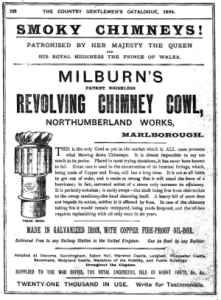 Designing Buildings (DB), parter platform for the IHBC’s ‘Conservation Wiki’ has posted a short history of Wind Cowels by Dan Rigamonti.
Designing Buildings (DB), parter platform for the IHBC’s ‘Conservation Wiki’ has posted a short history of Wind Cowels by Dan Rigamonti.
… Charles I granted a patent to the inventor of a rotating ‘smoke cure’… this became known as a wind cowl…
Dan Rigamonti writes in DB:
Fixed cowls were originally placed at the top of a chimney, like a hat, with slots to allow smoke to be released but preventing water or rain from entering, however, these cowls could not prevent driving wind which sometimes caused a down draft potentially blowing some dust into rooms. It is said that Charles I granted a patent to the inventor of a rotating ‘smoke cure’ during his reign, between 1625 and 1646 AD, this became known as a wind cowl, which was fitted as an add-on to prevent wind causing a down draught in the chimney….
One very modern interpretation and adaptation of the traditional wind cowl was invented by Bill Dunster OBE, the Architect of the UK’s first eco-village, located in Wallington, South London. Beddington Zero (fossil) Energy Development (BedZed) is a multi-award-winning development initiated by Bio-Regional, developed by the Peabody Trust in partnership with Bio-Regional Development Group, and designed by Bill Dunster Architects (now Zedfactory) with Arup….
See section headings at:
- 1 Early history
- 2 Thriving industry
- 3 Skyline of variety
- 4 Smoke to ventilation
- 5 Ventilation wind cowls
- 6 Related articles on Designing Buildings
See the full article
See more on the IHBC’s ‘Conservation Wiki’ and more background HERE
